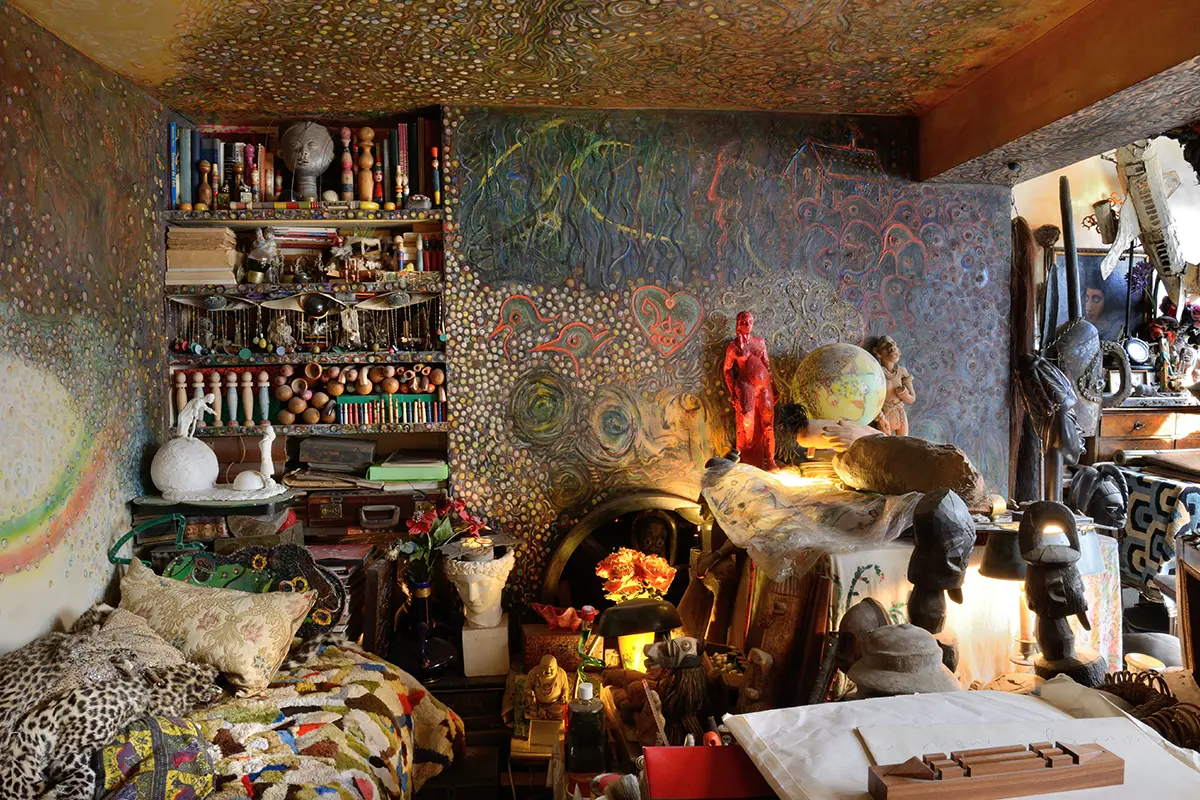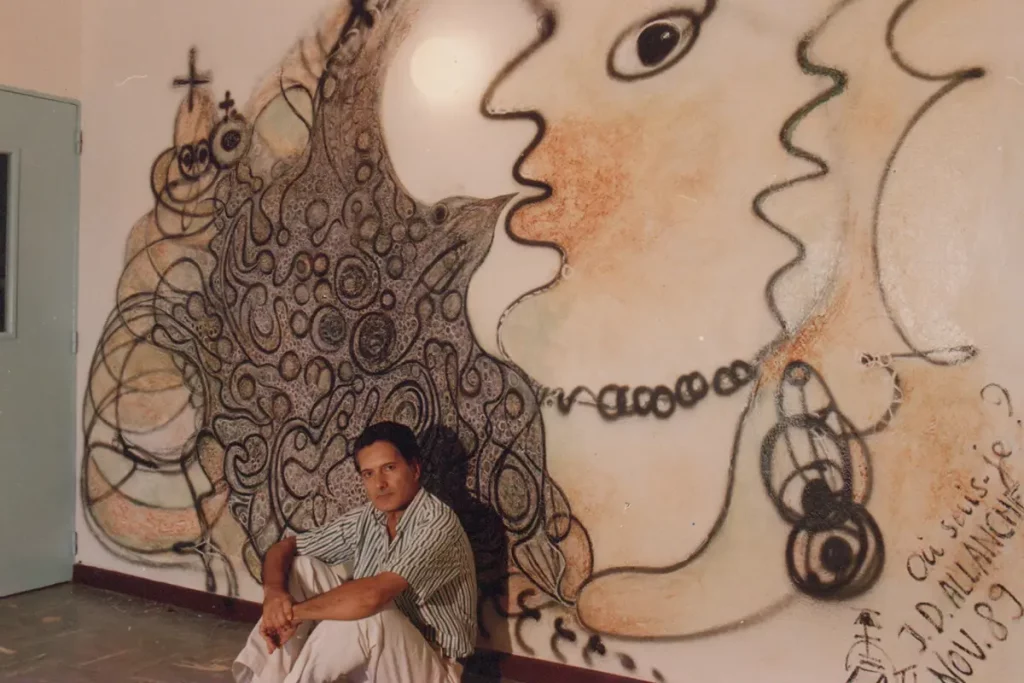A world of metaphysical obsession on the walls of his house – Lucile Allanche’s book of photographs and the Atelier Moléculaire
Lucile Allanche’s childhood and early relationship with her father Jean-Daniel Allanche: the walls of Atelier Moléculaire
«Everything circulated around him. At one point when he was traveling, because he worked in Africa where he taught Quantum Mechanics and Electromagnetism (he was sent by the Ministry of Education to teach in the newly opened universities), for about 10 years in total, we wrote letters, we exchanged letters».
Lucile Allanche, daughter of Jean-Daniel Allanche, was born in Lyon (France), but has spent most of her life in Paris. Allanche has jumped around from living in Singapore and Tokyo with her ex-husband and children, she spent the 80’s and 90’s working in the perfume industry. Allanche later found her way back to Paris in 2006. Upon her return, she started studying art at Christie’s Education. «I was always attracted to art. I collected art during my time in Asia».
The start of the Atelier Moléculaire: the walls, the house in the book L’atelier moléculaire de Saint-Germain-des-Prés by Lucile Allanche
«Some places he started in the 70s. He ended around 2000». Allanche’s parents divorced when she was very young. Allanche’s father lived in the sixth in Paris where he bought his flat in 1975. Lucile was living in Vincennes (Parisian suburb) and would visit him once a week. «It’s was on the sixth floor with no elevator, and it was basically all white. The project started from the rooms like the bathroom, and kitchen where there was a leak. It started from the back of the place. It was quite small, 40 square meters. There were two main rooms plus one toilet, one bathroom, and one kitchen. It was two lots combined together».
The start of the Atelier project was more of a natural progression than that of a planned long-term project. Jean-Daniel Allanche bought the studio space in 1975. The decoration itself started due to a leak in the bathroom, sparing the larger scale idea in Allanche’s mind. «I saw the whole process because he painted the whole flat from the floor to the ceiling. I saw the progression. We had the kind of relationship where I had to look at what he wanted to show me, and listen to his music. Everything was about him».
Jean-Daniel Allanche’s attraction to the Art world: L’atelier moléculaire de Saint Germain-des-Prés
«He wanted to be able to be a scientist, a poet, an artist, he wanted to develop all the potential he could have on his own». Allanche’s father never took any lessons in art growing up. He found that there was always a passion brewing inside of him. He never wanted to be deemed as solely one thing. Not just a scientist, or a physicist, or an artist, or a poet. He wanted to illustrate that one could do all these things simultaneously. He brought this juggling act into his own work. He felt that his purpose in creating art was to create balance.
«The subject was not the primary focus. What was central to him was how the colors came together. It all surrounded his search for harmony. He developed an harmonic theory between colors and the twelve chromatic tones».
His career as a physics professor never hauled during these thirty years of curation and creation. Jean Daniel Allanche continued to teach at the Université des Sciences Paris VII. He was both teaching as well as getting paid for his research on the side. This work never took up too much of his time, giving him the opportunity to continue his passions of music, poetry, and art.
«He told me to play the piano, or paint. I’m sure it influenced me in a way».
Jean-Daniel Allanche American Folk Art Exhibitions
«So how it happened, I have a friend, Hervé Perdriolle, who is an art critic and has a gallery in Brussels. At the time, the gallery was in Paris. He met my father two to three times before he passed away. My father didn’t want to show his work and when he travelled to the south of France, I told Hervé to come and he really liked what he saw in my father’s apartment. After my father’s death we put some pictures of the flat on Hervé Perdriolle’s gallery website, and started to show a few works at the Outside Art Fair in New York. It was a great success».
Once Jean-Daniel Allanche’s work had made its first appearance in the art world, he continued to show at the Outsider Art Fair three more times. His first exhibit at the American Folk Art Museum was in 2018, titled “Jean-Daniel Allanche: Piling Up the Dust of Memories,” in Vestiges & Verse: Notes from the Newfangled Epic, ed. Valérie Rousseau. The second exhibit was in 2022, titled “Multitudes”.
Jean-Daniel Allanche’s Metaphysical Obsession
«It was very personal, there were a lot of African statues as he lived for a total of 10 years between Congo, Bénin and Burkina Faso. Each time he brought back some sculptures. The walls were covered in only his own paintings, and they covered the doors, the ceiling, and even the carpet».
Jean-Daniel Allanche lived in this studio during the thirty years of him crafting it from head to toe. Each painting aligned with a theme he had in mind, whether it be that of Adam and Eve, where he painted snakes and wrote words of poetry, or the staircase he decorated into a tree. He loved to glue miscellaneous objects of different sorts to the artworks. The question for Jean-Daniel always concerned harmony.
«The main part of the actual studio itself was more about metaphysical obsessions. The space was not frightening, because there were no themes of death or sex. There was nothing scary or frightening. But it was very dark and closed, like a cave».
The Atelier space was essentially an extension of Jean-Daniel Allanche’s thoughts, passions, and desires. All the art that he digested over the years were incorporated across the ceilings, walls, and floors. Some of the artworks incorporated poetry he had written, or words he had found meaning in.
Although the pictures come out very clear in the published book, Lucile Allanche described the space as dark and heavy. Fascinating to look at, but impossible to live in.
«Even the heater was decorated. He put on it some earrings and added a nose and feet».
Jean-Daniel Allanche was devoted to art in every shape and form that it took on, whether it be the sculptures he collected from his travels, or the poetry he wrote and music he played outside of his teaching career, Lucile Allanche was always fascinated with her father’s work and distinct desire to multitask.
Lucile Allanche’s Desire to share her father’s work: L’atelier moléculaire de Saint-Germain-des-Prés
«It was very weird because he was very sick and he asked me what I wanted to do with this place. I said that I didn’t know and he didn’t tell me what to do or not to do. I was alone in front of this choice».
Due to Jean-Daniel Allanche’s illness in his final years, Lucile knew she wanted to do something to commemorate both his work, as well as his unique perspective on life. Although Lucile spent a lot of time at his studio and was in touch with her father throughout its curation, Lucile found that it wasn’t always clear what each of the artwork’s meaning was. In the book, Lucile does her best to give her own notes.
«It was very interesting to think, to see the walls and to figure out what he wanted to say». The process of rediscovering her father’s works of art served as a final goodbye for Allanche. Throughout the process of curating the book, Lucile Allanche tried her best to provide context for each of the artworks, allowing the audience to gain understanding for the way in which Jean-Daniel Allanche’s mind worked.
«For me it was impossible to live there. Then I didn’t want to rent it out because I would have to remove everything myself and repaint. I would have liked to make it like a museum for a short time. But it was not safe at all because of the six floors climb and the very narrow corridor. It was not possible to let people in so, I decided to remove everything that could be removed, from the mirrors to all the apartment doors, the carpet, everything that could be dismantled, and I sold the place».
Lucile Allanche knew that her father would be proud to know his work has been viewed and appreciated by a larger audience. Along with the book, Allanche will also make sure to have her father’s work distributed to different art centers. Some works, mostly pages of research, are now part of the Collection of the Pompidou Centre in Paris.
Lucile Allanche and L’atelier moléculaire de Saint-Germain-des-Prés
Jean-Daniel Allanche, Professor and Researcher in Physics, painted and repainted the walls and surfaces of his attic apartment that he acquired in 1976 in Saint-Germain-des-Prés, Paris. The murals of his home were complemented by an accumulation of collected objects, African sculptures, souvenirs of trips and places of living, objects of all kinds similar to a collection of modest art investing every nook and cranny. The title of the Book is L’atelier moléculaire de Saint- Germain-des-Prés.




















